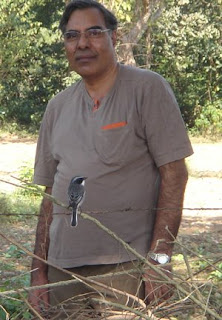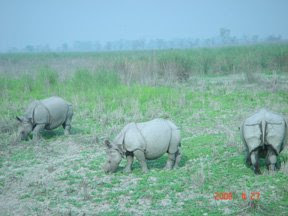Posted by
Susan Sharma
on
September 26, 2009

I was in Kangra (Himachal Pradesh) late October, just before winter set in. As always, the countryside is ever changing and never fails to reveal something new for my camera to capture. The mongoose family scurrying about the neighbour’s vegetable fields
was amusing.
http://backyard-wildlife.wildbytes.in/#25
So was the sight of giant wood spiders alongside walking paths. The females are nearly ten times larger than the males, I believe. They weave the strongest and largest spiderwebs known to us. Shiny legs with yellow joints are their hallmark. Giant wood spiders
are the subject of research- Humans would love to know the secret of creating the strong golden websilk. "In modern times, the Golden Orb Web Spider’s silk is set to become a major product. The silk is almost as strong as Kevlar, the strongest man-made material
which is drawn from concentrated sulphuric acid. In contrast, spider silk is drawn from water. If we could manufacture spider silk, it would have a million uses from parachutes, bullet-proof vests, lightweight clothing, seatbelts, light but strong ropes, as
sutures in operations, artificial tendons and ligaments. Studies are now being done to have genetically engineered plants produce fluid polymers which can be processed into silk".
http://backyard-wildlife.wildbytes.in/#24
The wild red and white berries were all over.

The fields had spawned metallic mushrooms which vied with the pebbles lying around.

My husband was only too pleased to pose for a photo, framing a wagtail which he was pointing out to me!
 More on my next visit!
More on my next visit!
|
Posted by
Susan Sharma
on
August 22, 2009
August 15, Independence Day- An ideal day to check out the hill station near to Chandigarh since we were already in Chandigarh on a visit.
The weather was good. It had rained for two days so the drive up was picturesque. We stopped the car many times just to take in the scenery. On the way we passed many other cars doing the same. Ha! this is like heaven after the hustle bustle of daily life.
Scenic view from nature camp. Double click on the photo and notice the blue water tank on the left.
 Read the full report at the link
Read the full report at the link
http://travelphotolog.blogspot.com
|
Posted by
Susan Sharma
on
May 06, 2008

We also managed an elephant ride into the 20 sq. km rhino enclosure . The rhinos seemed placid , chewing on elephant grass, which came to life with jumping hog deer as we maneuvered our wa y. y.
The jeep ride into the forest in the evening proved exciting- Herds of swamp deer could be seen from the machan. The deer had shed their antlers, which were sprouting again for the next mating season display. The pugmarks of an adult tigress
and four cubs seemed very recent and we followed them. Sure enough the huge tigress surprised a herd of sitting swamp deer into sudden action. Calls by langur and deer filled the forest air. The whistle of a train came from the distance and a speeding train
could be seen in the horizon view from the machan. The Gonda-Bareilly railway line passes through the National Park. Animals in this reserve must be quite used to this noise by now. One tiger and two elephants died in the tracks recently, Sonu, our guide informed.
Ten trains run through the reserve in one day and every now and then we encountered people collecting fodder and dried wood in the forest. The train station located right inside the reserve carried people in and out regularly making a mockery of National Park
rules.
Tigers and people are living on the edge in this Tiger Reserve, which obviously had a very good prey base. Herds of hog deer and a few barking deer and chital greeted us on the jeep route. Wild hog, another favorite of the tiger also showed themselves often.
Swamp deer herds, which kept near water bodies, avoided tourist routes, but were obviously thriving as well.
Read the full report at
http://www.indianwildlifeclub.com/usercontent/userArticle.asp?id=27
|
Posted by
Susan Sharma
on
February 04, 2008

Ecotourism- Impact on wildlife
The latest environmental issue attributed to eco-tourists is a massive threat to an already endangered species. It appears that the tourists may be passing potentially deadly diseases to the great apes they spend so much money to view in the wild.
Every year the economies of African nations receive a boost from wealthy tourists willing to spend thousands upon thousands of dollars for the chance to get up close and personal with majestic gorillas and chimpanzees. But new evidence has come to light
suggesting that humans are infecting the apes with deadly respiratory viruses.
The first direct evidence linking human contact to disease deaths of great apes was found in the Ivory Coast. Chimpanzees at the West African nation’s Tai chimpanzee research station were killed by human respiratory syncytial virus (HRSV) and human metapneumovirus
(HMPV).
This throws a wrench into the eco-tourism equation. Tourist money has undoubtedly had a positive impact on both the economies of desperately poor African nations and the situation of endangered great apes. Eco-tourism helps fund conservation projects and
has reduced poaching by making the animals more valuable alive and in their natural habitat than they would be dead. However, an outbreak of a virus carried by an unwitting eco-tourist could potentially wipe out an entire community of apes, which could drive
the endangered species toward extinction.
Scientists have proposed that all humans in close contact with the animals be forced to wear a mask. The mask rule would have to apply to all eco-tourists, as most people would be completely unaware that they were carrying a deadly virus. The viruses generally
have no symptoms in humans. Conservationists also want to increase the distance that must be kept between human and ape. Currently, tourists must stand at least seven metres from the animals, but there are calls to increase that to 10 metres.
Source: Guardian Unlimited
http://www.guardian.co.uk/environment/2008/feb/03/conservation.endangeredspecies?gusrc=rss&feed=environment
|
Posted by
Susan Sharma
on
December 13, 2007
According to the International Ecotourism Society, the market for conservation-oriented tourism continues to grow; in 2004, worldwide ecotourism and nature tourism were growing three times faster than the tourism industry as a whole.
The popularity of nature-based travel led the United Nations to hold a World Ecotourism Summit and declare 2002 the International Year of Ecotourism. More than 55 million Americans are interested in sustainable travel, which protects both environment and
culture, according to a study by the Travel Industry Association of America sponsored by National Geographic Traveler.
Source:
http://travel.nytimes.com/2006/12/17/travel/17journeys.html
|
Posted by
Susan Sharma
on
November 24, 2007

Trek on Foot!
Long-distance hiking is incredibly romantic — the idea of spending weeks
or months at a time in some of the most beautiful backcountry areas in the
world is almost universally appealing, especially when contrasted to the
fluorescent lights, traffic jams, and overwhelming email inboxes of modern
life. But long-distance newbies need to realize that the reality of
long-distance hiking is not always pleasant: you can’t just “float” by like
you can in “the real world” — there are always miles to be walked, stormy
weather to fend off, fatigue and soreness to treat, discomforts to cope
with, etc. You have to earn the “Beautiful moments” — the sunsets, wildlife
encounters, 12,000-foot ridgewalks, and trail magic from generous locals.
If you understand the work-to-reward ratio of long-distance hiking, and if
you’re okay with it, you’ll have much more success and you’ll enjoy yourself
much more.
For new trekkers:
1. Familiarise yourself with all that you can read about the place.
2. Read trip reports by others
3. Develop skills, become more familiar with your gear and
maps/guidebook, and understand better the terrain and weather. Ideally go
with a more experienced backpacker who can transfer knowledge they have
learned from others and from their trials and errors.
|
Posted by
Susan Sharma
on
September 16, 2007
Marine resources and environment protection in India has a long way to go. Our neighbouring countries can provide case studies and success stories which can be a great learnng experience for our marine scientists and conservationists.
The 5th Asia Pacific EcoTourism Conference (APECO) is taking place in Terengganu, Malaysia on 27th and 28th October this year. The theme is Marine Ecotourism: Best Sustainable Practices and Success Stories. The Conference will address these challenging issues
and learn how to manage marine ecotourism through sustainable practices particularly in the Asia Pacific region. The conference also has special sessions on conservation of marine resources.
The details of the conference are avavilable at
http://www.apeco2007.com/
|
Posted by
Susan Sharma
on
August 23, 2007
Singapore’s government is encouraging the city-state’s hotels to go green. Under a new scheme run by the National Environment Agency (NEA), energy-efficient hotels can compete for an “Energy Smart” label. To gain this distinction, they must measure themselves
against a set of energy benchmarks devised by the NEA and the National University of Singapore.
The NEA is also helping to fund the energy audits. The winners of the inaugural award in August were the Regent, the Shangri-La, the Intercontinental and Changi Village. But much work still needs doing: hotels currently account for a whopping 2% of Singapore’s
greenhouse gas emissions.
|
Posted by
Susan Sharma
on
August 14, 2007

In recent years many western communities have shifted their reliance from drilling, mining and logging to recreational activities like camping, fishing, hunting, skiing, climbing and boating on public lands for jobs, economic growth and vitality.
According to a report prepared by Sierra Club, outdoor recreation across the American West generated more than $60 billion and over 600,000 new jobs in 2006 alone. Western communities situated closest to federally protected public lands showed the strongest
economic growth in recent years. The Sierra Club says it is working to get traction for this information so that policymakers and the public can counter industry propaganda about the need to increase drilling, mining and logging on Western lands.
“Public lands drive the tourist-based economies in our western states,” says the Sierra Club’s Keren Murphy, who authored the report. “If we protect special places, they’ll provide a source of income and enjoyment for generations to come.”
Source:
Sierra Club
http://www.sierraclub.org/wildlegacy/downloads/2007publicwildlandsreport.pdf
|
Posted by
Susan Sharma
on
May 13, 2007

Key comments in a survey conducted by Planeta.com
How do you characterize ecotourism in the country where you live? Provide examples of best or worst practices
PAKISTAN - Ecotourism is a new concept in Pakistan. Some people understand its true concept but most of the people in travel trade are not
fully aware about the concept
INDIA - Ecotourism is becoming one of the major attractions of Kerala. In this small state, ecotourism activities and programs are mainly
in the wilderness areas. Ecotourism programs in the Periyar Tiger Reserve, Chinnar Wildlife Sanctuary and Chimmony Wildlife Sanctuary are the examples of best practices, because of the participation of the local community. Worst practices are the business
magnets trying to project themselves as leaders of the ecotourism bandwagon of Kerala. The whole tourism management authority of government is being manipulated by this highly influential group
What are the noteworthy achievements in ecotourism in the past five years?
PAKISTAN - In Pakistan people from travel trade have started thinking more seriously the negative impacts of general and tourism and there is better growth of understanding about the
concept of ecotourism during the last five years.
INDIA - In India, especially in Kerala, more travellers and entrepreneurs have become aware of ecotourism. Indigenous people are making an alternate livelihood from these programs in the Reserves
i mentioned earlier, and in turn, they are working with the state forest department to protect the jungles they live in which is indeed a noteworthy achievement.
Source:
http://www.planeta.com/ecotravel/tour/yearplusfive.html
|